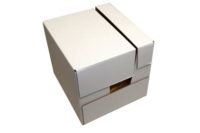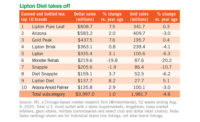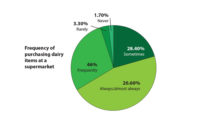PMMI, The Association for Packaging and Processing Technologies, described the changing face of the North American dairy industry in its report, “Dairy Industry — A Market Assessment” (September 2013). Consumers were, and still are, attracted to new products, flavors and packaging to match their on-the-go lifestyles. Retailers, naturally, pass those demands on to their suppliers.
Big Box retailers are powerful players in these markets, and one of their major demands is retail-ready packaging (RRP). According to a cheese and yogurt packaging engineer interviewed by PMMI, “Pegs are being removed in stores like Walmart and Target, with a growing demand for more retail-ready and more stand-up pouches.”
That’s no anomaly, according to a May 2014 study from PMMI. In the United States, food accounts for 76% of RRP volume, beverage for 15% and non-food for 9%, as reported in “Retail Ready Packaging.” Find it in the Research & Trends area of PMMI.org at http://www.pmmi.org/Research/?navItemNumber=496.
Where RRP grows
The growth of RRP is a global phenomenon fueled by urbanization, population growth, economic growth and the proliferation of supermarkets, the report asserts. Europe’s market ($24.7 billion) is the largest, growing at a compound annual growth rate (CAGR) of 1.6% for 2012 to 2015. The United States saw its market at $5.5 billion in 2012, projected to grow to 1.7% CAGR.
The RRP market tends to grow along with economic development, so it should come as no surprise to markets like Asia (5.5% CAGR), Africa (4.6% CAGR) and Central and South America (3.7% CAGR), which are strengthening their retail and manufacturing sectors.
That gives retailers a lot of influence over RRP decisions, a point made in the Dairy Industry assessment as well as this RRP analysis.
The power of the big boxes
OEMs, manufacturers and retailers agree: Big box stores drive the market. The sheer volume of product they buy and sell gives them considerable pull in setting terms with manufacturers. That influence can even include decisions on packaging machinery, the report notes.
For reasons that include flexibility, more than half (57%) of those we interviewed would rather invest in specific components than in machinery dedicated to RRP. When they do make the decision to invest in machinery dedicated to retail-ready packaging, it’s frequently to meet the needs of a large customer.
In the words of one respondent: “Say you are a big CPG, and you have 18 lines in a plant. Walmart says, ‘Nine of your lines run Walmart business. You’re going to run this type of line, or we will go resource it from China.’ ”
Another major incentive to the supermarket or big box store: reducing the time and labor needed to prepare products for display. For example, the report notes, retail-ready packaging developed for Kraft’s Philadelphia brand reduced the need for raw materials and cut 80% of retailers’ work readying a display from 15 steps down to three.
Find RRP answers at Pack Expo
You can expect to find solutions to your RRP challenges at Pack Expo International 2014 (Chicago, Nov. 2 to 5) — particularly in The Brand Zone, home to materials and containers that shape winning brands. Learn more and register at Packexpointernational.com.




